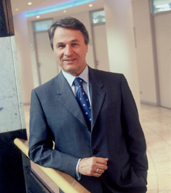
Work Distribution/
Revised
Personas
Task
Scenarios
Initial Design Ideas: Brianna Bridger
 D.
Mann Esq. activates and checks for alerts concerning his commute the next
morning
D.
Mann Esq. activates and checks for alerts concerning his commute the next
morning
D. takes pride in the fact that he answers to few people. He feels that he’s earned the right to leisurely starts to the day. Rarely scheduling appointments before 9:30 am, D. is left with plenty of time to swim 25 laps and have two cups of coffee with his croissant and Washington Post. However, tomorrow, his secretary has scheduled an 8 a.m. teleconference call with the firm’s partners in Houston. This irks him but after thinking about it, he concludes that plenty of time remains for a full night’s rest and a brief swim to loosen up before work. He sets two alarm clocks for 6:00 am to ensure he wakes up in time for the early start. Then he turns on his laptop and brings up the freeway traffic monitoring system his racketball partner referred him to. He specifies the location of his home in Los Gatos and his office is in the city. He also lets the system know that he must arrive at or prior to 7:45 am. Quickly he finds and activates traffic alerts. The system suggests a conservative departure time of 6:30 am. The next morning, when 6:00 am rolls around, D. feels groggy and cheated of his hard earned privilege to sleep in. He wakes his laptop from sleep. The traffic monitor is still active from the previous night. He notices that 880 is slightly congested relative to its normal state at 6:00 am. D. decides that swimming now would be unwise. Rather than risk the possibility of embarrassment among his peers, D. decides to leave 30 minutes early.
 Brianna
Bridger finds a better commute route
Brianna
Bridger finds a better commute route
A friend tells Brianna about Road Sage and recommends it as a great, relatively painless way to find out about public transit options in a way that tailors them to her specific travel needs. She registers for a free account at the Road Sage site and finds out that, in order for the system to provide her this service, it needs to know where she’s going and where she’s coming from.
She tells the system where she lives, where she goes to school, the times
when she has to arrive at school and when she leaves school. It turns
out there’s a bus Brianna didn’t know about that can get Brianna
and her bike to campus on Mondays, Wednesdays and Fridays, ten minutes
before class begins! Brianna’s thrilled that she no longer has to
drive and pollute the air during the week.
 Manolo
Innskeep takes a Weekend Trip to Santa Cruz
Manolo
Innskeep takes a Weekend Trip to Santa Cruz
Manolo Innskeep is heading to Santa Cruz tomorrow from San Francisco for a leisurely weekend getaway. He drove to Santa Cruz a few times years ago so he’s somewhat familiar with the different routes that will lead him there, but he wants to see what the traffic looks like at different times along the best routes.
Manolo goes to the Road Sage web page. He specifies the day he'll be travelling, along with his starting point and destination. He also enters his preferred time of day for travel. The system responds by calculating all possible routes from San Francisco to Santa Cruz. Road Sage estimates travel times for the various routes, based on historical patterns, time of day and day of week. Manolo interacts with the map visualization that uses the fastest route at the optimal time of day tomorrow as a starting point, with visual indications of traffic levels along the way, as well as an indication of trip length and arrival time. Clear, easy-to-use controls allow Manolo to dynamically adjust his route and departure time; doing so causes immediate visual changes in the map to indicate expected traffic levels along the way as well as trip length and arrival time.
The system provides flexibility for Manolo to comfortably consider, choose and print alternate routes for his weekend drive.
 Aymanna
Holiday goes to the doctor
Aymanna
Holiday goes to the doctor
Aymanna Holiday wants to make an appointment with a doctor who was recommended to her by a friend. The doctor's office is in Hayward; she works in San Jose and lives in Mountain View. Her intention is to take an early morning appointment next Tuesday and tell her boss that she'll be about 1 hour late.
However, she has the flexibility to schedule her appointment at any time on that day, and she wants to avoid traffic as much as possible. She goes to our website and enters her home address as her origin and the doctor's office as the destination, and chooses 'Tuesday' as her day of travel. She sees that according to our statistics, one-way travel time to Hayward, starting at 7am, going over the Dumbarton Bridge and then north on 880, would be about an hour.
By sliding the time slider to 9:30 am, which is when she would ideally like to starting driving back to work, she sees that several segments of southbound 880, which is what she'd have to take to get to San Jose, are still colored in red (avg. speed < 30 mph). In fact, by further sliding the slider, she realizes that SB 880 is generally jammed up until 10:30-11am. Clearly, this way she won't make it to work at any reasonable time. However, as she slides further, she sees that 880 clears up in both directions after noon.
She changes her departure point to her office address, slides the time pointer to 12pm; now the travel time is ~30 min. Going back at 1 or 1:30pm, the travel time back to San Jose is still 30 min. She decides to tell her boss instead that she'd take a longer lunch and stay longer in the evening; this way, she only spends an hour in the car instead of +2 hours, and avoids the aggravation of being stuck in traffic.
Aymanna Holiday finds new routes to work
Aymanna’s distaste for driving in the Bay Area has been accumulating. Last week she found herself 20 minutes late for work and in a shouting match with an elderly man who held up traffic by driving 40 mph on the expressway. Asking her friends for advice has illustrated that alternative travel options are out there. For example, her officemate Derrick lives in Fremont. Instead of fighting traffic on the 101 into San Jose, Derrick travels through to the city in the opposite direction of San Jose and returns on I-80. This route that Derrick takes is much less congested than 101. He has discovered that he spends equal time on the road between the two alternate paths. At the same time, he avoids the not so occasional traffic jams that build up from the congestion on 101 in the morning. Most mornings he arrives at work in light mood because the almost serene drive provides an opportunity to plan his day. Aymanna wants more options like Derrick’s. After hearing about the traffic monitoring system, she finds, installs, and runs the application on her WAP enabled pocket PC. She specifies the location of her home in Mountain View, the location of her office in San Jose, and the time she must arrive each morning (9 am). The system then provides her with five new alternate routes, each along with estimated travel time. Aymanna is thrilled. She plans to try each route (even those with longer travel times) systematically beginning the next morning. She is glad to invest more time in her morning commute in exchange for possible, long-desired peaceful and quiet travel.